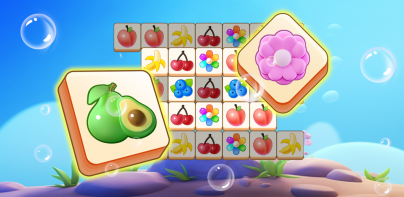


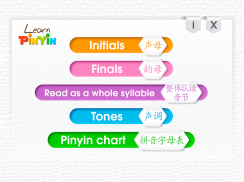
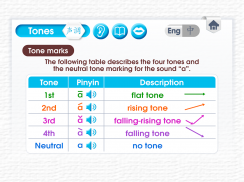
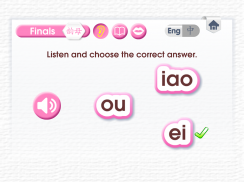
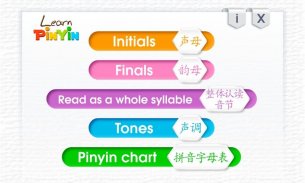
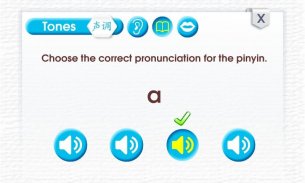
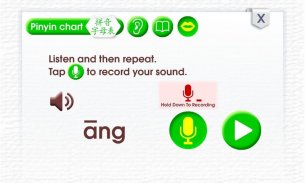
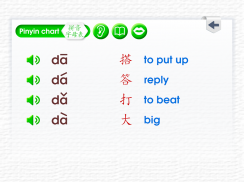
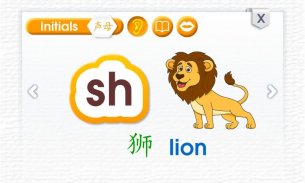
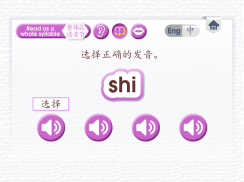
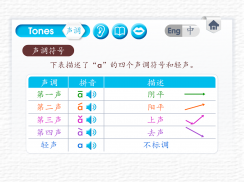
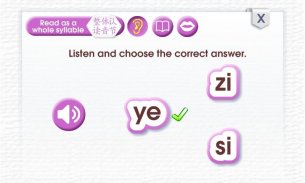
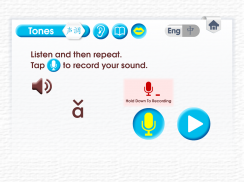
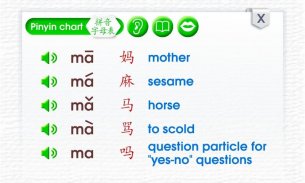
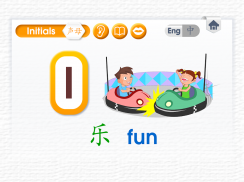
Learn Pinyin

คำอธิบายของLearn Pinyin
Pinyin, short for Hanyu Pinyin, means "phonetic notation" or "phonetic symbols". Pin means "spelling" and Yin means "sound(s)". Pinyin is a system of romanization (phonemic notation and transcription to Roman script) for Standard Mandarin. There are 21 initials/consonants and 35 finals/vowels in Mandarin.
Pronunciation of Mandarin comes with two aspects: syllables and tones. Each can be practised separately, but when it comes to speaking, learners must pronounce words with proper tones.
A Mandarin syllable consists of three components: an initial, a final and a tone. The initial and final sounds make a total of 56 basic sounds. Combinations of initials and finals, and the special cases result in more than 400 mono-syllabic sounds. By applying the four tones to the sounds, Standard Mandarin makes a total of around 1,600 unique syllables.
Initials and Finals
The pronunciation of Chinese Pinyin is generally given in terms of initials and finals, which represent the segmental phonemic portion of the language, rather than letter by letter. Initials are initial consonants, while finals are all possible combinations of semivowels coming before the vowel, the nucleus vowel, and final vowel or consonant.
A semivowel is a sound that is phonetically similar to a vowel sound but functions as the syllable boundary rather than as the nucleus of a syllable.
Tones
Mandarin Chinese is a tonal language. Each Chinese character/syllable has a tone. The same syllable can have 5 possible ways to pronounce by varying the tone (pitch). There are four main tones and a neutral tone (轻声qīngshēng) in Mandarin. One syllable, pronounced in different tones will usually mean different things. This fact makes the tone training a fundamentally important part of Mandarin learners. So, even if you can pronounce the pinyin of a Chinese character correctly but if you do not master tones, Chinese speakers will not understand you.
If you have suggestions on how we can improve this application, please send us your feedback. We value your input; it can make a world of difference to the learning experience of other learners who use this app.
E-mail us at: admin@e-unik.com.my
Pinyin ย่อมาจาก Hanyu Pinyin แปลว่า "สัญกรณ์สัทศาสตร์" หรือ "สัญลักษณ์สัทอักษร" พินหมายถึง "การสะกดคำ" และหยินหมายถึง "เสียง" พินอินเป็นระบบของสุริยวรมัน (สัทศาสตร์สัทศาสตร์และการถอดความเป็นอักษรโรมัน) สำหรับภาษาจีนกลางมาตรฐาน ภาษาจีนกลางมีทั้งหมด 21 ตัวอักษร / พยัญชนะและ 35 รอบชิงชนะเลิศ / สระ
การออกเสียงภาษาจีนกลางมีสองด้านคือพยางค์และโทนเสียง แต่ละคนสามารถฝึกฝนแยกกัน แต่เมื่อพูดผู้เรียนจะต้องออกเสียงคำศัพท์ด้วยน้ำเสียงที่เหมาะสม
พยางค์แมนดารินประกอบด้วยสามองค์ประกอบ: เริ่มต้น, สุดท้ายและเสียง เสียงเริ่มต้นและขั้นสุดท้ายทำให้มีทั้งหมด 56 เสียงพื้นฐาน การรวมกันของชื่อย่อและรอบชิงชนะเลิศและกรณีพิเศษส่งผลให้มากกว่า 400 เสียงพยางค์เดียว ด้วยการใช้สี่เสียงเพื่อให้ได้เสียงภาษาจีนกลางทำให้มีพยางค์ที่ไม่ซ้ำกันประมาณ 1,600 เสียง
ชื่อย่อและรอบชิงชนะเลิศ
การออกเสียงของพินอินภาษาจีนนั้นโดยทั่วไปจะให้ในรูปแบบของชื่อย่อและรอบชิงชนะเลิศซึ่งเป็นตัวแทนของส่วนสัทศาสตร์ของภาษามากกว่าตัวอักษรโดยตัวอักษร ชื่อย่อเป็นอักษรย่อเบื้องต้นในขณะที่รอบชิงชนะเลิศเป็นชุดที่เป็นไปได้ทั้งหมดของ semivowels มาก่อนเสียงสระนิวเคลียสเสียงสระและเสียงสระสุดท้ายหรือพยัญชนะ
semivowel เป็นเสียงที่มีการออกเสียงคล้ายกับเสียงสระ แต่ทำหน้าที่เป็นขอบเขตพยางค์มากกว่าเป็นนิวเคลียสของพยางค์
เสียง
ภาษาจีนกลางเป็นภาษาวรรณยุกต์ แต่ละตัวอักษร / พยางค์จีนมีน้ำเสียง พยางค์เดียวกันสามารถมี 5 วิธีที่เป็นไปได้ในการออกเสียงโดยการเปลี่ยนโทนเสียง (pitch) มีสี่เสียงหลักและโทนกลาง (轻声qīngshēng) ในภาษาจีนกลาง หนึ่งพยางค์ออกเสียงในโทนสีที่แตกต่างกันมักจะหมายถึงสิ่งที่แตกต่างกัน ข้อเท็จจริงนี้ทำให้การฝึกอบรมเป็นส่วนสำคัญของผู้เรียนภาษาจีนกลาง ดังนั้นแม้ว่าคุณจะสามารถออกเสียงพินอินของตัวอักษรจีนได้อย่างถูกต้อง แต่ถ้าคุณไม่ใช้เสียงต้นแบบผู้พูดภาษาจีนจะไม่เข้าใจคุณ
หากคุณมีข้อเสนอแนะเกี่ยวกับวิธีที่เราสามารถปรับปรุงแอปพลิเคชันนี้โปรดส่งข้อเสนอแนะถึงเรา เราให้ความสำคัญกับการป้อนข้อมูลของคุณ; มันสามารถสร้างโลกที่แตกต่างจากประสบการณ์การเรียนรู้ของผู้เรียนคนอื่น ๆ ที่ใช้แอพนี้
ส่งอีเมลถึงเราที่: admin@e-unik.com.my







